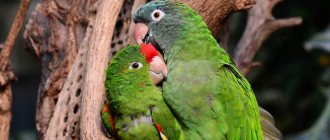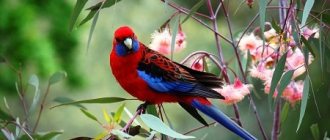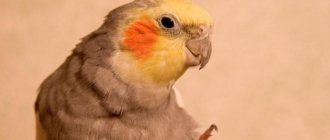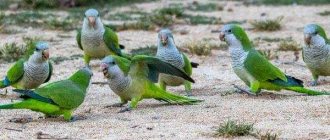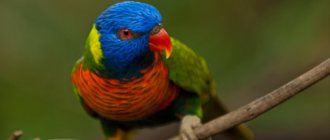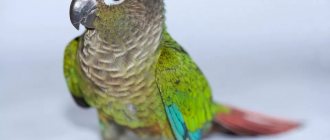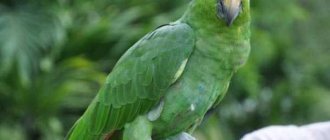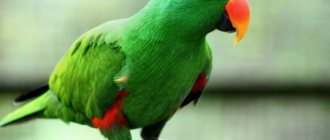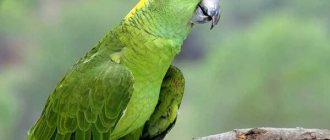The Amazon Parrot is a bird for those who value intelligence, sociability and beauty. If this is your first time getting a parrot, know that this representative is an excellent choice even for beginners. Reviews from owners are mostly positive: active, cheerful, friendly, sociable, lively, inquisitive, smart, artistic, loving their owners and at the same time noisy, arrogant, quarrelsome and talkative, especially in the morning.
Let's talk about keeping and caring for these unusual pets so that communication between you brings mutual pleasure.
Amazons in natural conditions
Amazon parrots are native to Central and South America and prefer to live in humid savannas and tropical forests. These birds are gregarious, staying in small friendly groups. And only during the mating season do they split into pairs.
In nature, Amazons spend most of their time on high branches, feeding on tree shoots, leaves, flowers, seeds, nuts and fruits. Like all birds, these parrots wake up early, with sunrise. The first thing the Amazons do after waking up is to shout to each other about the news of the past night. Most of the day is spent searching for food and water.
Information
They are looking for places to create a family hearth in hollows. The clutch consists of 2 – 5 eggs, the incubation period lasts for 3-4 weeks. In their native lands, individuals eat cocoa fruits, palm trees, fruits, seeds, nuts, and berries. Individuals often destroy crops, leaving the local population without the gifts of nature. In recent times, Indians caught parrots and ate them as food, the taste of which resembles chicken meat.
After the visit of Europeans, the number of orders of Venezuelan parrots decreased significantly due to export to another region. The bird was cooked and used as an exotic delicacy. But the Europeans did not like the meat and the bird was recommended for sale to inspire the sad eyes of tourists and rich people. The sex can be determined after the pets have mated. Because outwardly the birds are exactly the same.
What does an Amazon parrot look like?
Amazons are classified as large parrots in size. Their body length can reach from 25 to 45 centimeters. And Amazons can weigh up to 700 grams. It all depends on the species.
These exotic birds are stocky in build, with a short and rounded tail. The Amazon parrot has a powerful beak, so it can stand up for itself, even though its character is calm.
The main color for the color is green, which is complemented by spots of other shades: yellow, red, blue and lilac. They are usually scattered over the head, back of the head, neck, tail and wings. It is by the colors of these spots that the species of Amazonian parrots are distinguished.
Spreading
The population is colonized in Topeka South America: Brazil, Venezuela and Colombia. It is considered one of the 32 breeds of parrots found in the Amazon. The genus is distinguished by the peculiarity of green plumage with the inclusion of lilac, blue, red, blue, and yellow shades. Venezuelan parrots thrive in swampy, damp areas and prefer to stay in tropical thickets and forests. The nature of the pets is sweet and friendly, but only the owner shows affection and affection.
Brave pets are not afraid to make noise in front of guests, thus attracting attention and drawing them into conversation.
Types of Amazon parrots
Today, about 30 species of Amazons are known. Of these, 2 are considered extinct, and 18 are endangered and are listed in the Red Book. We list only those species that are most often sold for home keeping. It is worth choosing a pet from them.
- Yellow-fronted.
- Red-faced.
- White-fronted.
- Blue-fronted.
- Blue-cheeked.
- Yellowneck.
- Amazon Muller.
- Cuban.
- Festive (festival) parrot.
- Venezuelan Amazon.
Price
The price varies from 15,000 to 200,000 rubles. Such a difference in the amount is reflected in the character of the bird; wild ones are cheap, tamed ones are more expensive. The Venezuelan favorite is a difficult bird; the breed prefers communication and games. The character is somewhat capricious; even a small degree of severity of the disease cannot be neglected.
The cage is a confinement, the birds experience loneliness, separation, it is not recommended to leave the pet alone for several days. The cage with your pet can easily fit into the trunk of a car. The character of the Venezuelan pet breed is sociable.
Previous
All types of Lori parrots - a multi-colored breed with a brushed tongue
Next
All types of Aratinga parrot, its types and features
Characteristics of the Amazon parrot
Usually the first feathered pet in the house is a budgie. People are afraid to own larger exotic birds for various reasons. Although all fears are not justified. Amazon is exactly the bird that won’t spoil the first impression.
Parrots of this breed are calm, not vindictive, cooperative, friendly towards people and love their owners. Amazon parrots make wonderful companions. They are distinguished by their activity, curiosity and, as stated in the cartoon “The Secret of the Third Planet”, intelligence and intelligence. If an Amazon becomes attached to a person, then he will rarely refuse affection and “scratching”.
Changeability in mood is a character trait of this exotic bird. The parrot was just singing and jumping on its perch, and now it’s sitting offended, turning to the wall. You just need to get used to this behavior. The Amazon parrot has this strange character trait.
Reviews from owners also talk about the disadvantages of these birds. Amazons are arrogant and very demanding of attention. If they get bored, they will definitely notify you of this by shouting. They can behave impudently, misbehave and are not afraid of anything. So from the first days of this bird’s appearance in the house, special attention should be paid to its upbringing. As soon as the parrot gets used to the new place, you can teach him the rules of behavior. Amazons are smart, they will quickly understand what is what and what rules should be followed.
You need to be able to distinguish a demanding cry for attention from morning and evening rituals. As in nature, at home these birds will conduct a noisy roll call in the morning. And in the evenings, the Amazon parrot loves to sing loudly. Reviews from owners of these birds indicate that it is worth putting up with this behavior and treating your feathered pet with understanding. Amazon will also not be silent during the day. Parrots, in principle, love to sing songs, so melodious and not so melodic trills will always be heard in your house.
Table: possible diseases of the Venezuelan Amazon and methods of combating them
| № | Problem and manifestations | Solution methods |
| 1 | Violation of the temperature regime and the presence of drafts can trigger the development of a cold. The parrot begins to sneeze and becomes weak. | If there are several Venezuelans in a cage, the sick bird should be placed in a separate enclosure to prevent the spread of infection. Therapy consists of providing the pet with warmth. Place a regular or infrared lamp near the cage, after a while the temperature will rise to +30°C..+35°C. This will be enough for the parrot to recover. |
| 2 | Excessive feeding leads to the development of obesity. In particularly serious cases, the bird experiences shortness of breath, the parrot loses the ability to fly, and lays unfertilized eggs. | To normalize your pet's weight, review its diet. Be sure to include fruits and vegetables. The amount of feed should not exceed 50 g per day. Give your parrot the opportunity to fly around the room; physical activity will promote weight loss. |
| 3 | Some females may experience difficulty laying eggs. Young individuals are especially susceptible to this. The female sits in the nest for a long time and pushes to no avail. Then she becomes lethargic, her body temperature rises, her appetite decreases or completely disappears. The cause of the disease is mainly irregular cleaning of the cage, which is why pathogenic microorganisms penetrate into the oviduct. But difficult masonry can occur even if all hygienic requirements are met. The reason in this case is that the egg is too large or its position is incorrect. | Many owners do not know what to do in such a situation, but the problem can be determined by palpating the abdominal cavity. There is a stuck egg in this place. Without appropriate measures, the bird will die from exhaustion, poisoning of the body with toxins that are released from the accumulated feces. To help the female, you need to inject 3-4 drops of vegetable oil into the cloaca, wash the lower abdomen with warm water and massage this area with your fingers. After 2-3 hours the bird should lay eggs. If this does not happen, remove the egg with tweezers or contact your veterinarian. |
| 4 | If you notice that your bird's limb is swollen and hanging in an unnatural position, it could be a fracture. For a reliable diagnosis, you must contact a veterinary clinic. | As a therapy, you will need to make a fixing pad. Prepare tires from sticks or thin plywood. Place the paw or wing in its natural position, apply fixing material and a plaster cast for 10 days. If the fracture is open and bleeding is observed from the damaged limb, first of all, it must be stopped. To do this, soak a cotton swab in 3% hydrogen peroxide and apply it to the sore area. |
| 5 | Lack of nutrients leads to vitamin deficiency. In parrots, the eyelids and mucous membranes of the eyes become inflamed, purulent discharge appears, and trembling of the limbs can be observed. The bird throws its head back and becomes passive. | To replenish the parrot’s body with the necessary substances, you need to introduce sprouted grains of oats and wheat, as well as vegetables, herbs and fruits into its diet. |
| 6 | If the bird is kept in a cramped cage, the pet's beak and claws may grow excessively. At the same time, the parrot is unable to independently take food and move around the perch. | Choose an enclosure of the appropriate size, place pieces of wood or branches there so that your pet can grind down its claws and beak. The Venezuelan Amazon cage must not contain birds of any other species. The parrot will perceive them as potential opponents and show aggression towards them. Birds can behave in a similar way during the breeding season. |
| 7 | Manifestation of aggression on the part of a bird living alone. The parrot can even attack its owners. This may indicate a lack of attention or a hormonal surge (occurs during the breeding season). The parrot begins to scream loudly, chew toys and cage bars, and sometimes refuses food. | Provide your pet with proper care. Keeping a parrot in an apartment requires the attention of all household members. |
Amazon Intellectual Abilities
Typically, parrot owners are interested in whether they can learn to talk. Amazons are very capable birds in this regard. They can easily memorize up to fifty words and learn poems and songs. Of course, the construction of phrases in these parrots cannot be called ideal; they often make funny mistakes in imitating human speech. But Amazons are talented at copying other sounds: laughter, coughing, doorbell ringing, phone beeping, cat meowing, etc.
What else is interesting about the Amazon parrot? Reviews from owners say that this bird can become a real circus performer. Teach your pet to come when called, turn around, dance and even play basketball! While learning tricks with your feathered pet, both the parrot and the owner will enjoy it.
What is wrong with the Amazons?
If certain requirements and conditions are not met, parrots acquire the following types of diseases:
- self-plucking;
- feather deformation;
- baldness;
- parasitic lesions;
- dermatitis;
- hyperkeratosis;
- xanthomatosis;
- tumors;
- fractures and dislocations;
- arthritis;
- damage to the coccyx;
- problems with the thyroid gland;
- rhinitis;
- sinusitis;
- chicken cytoditosis;
- beak deformation;
- inflammation, kidney tumors;
- difficulty or excessive egg laying;
- eye problems;
- poisoning, etc.
Blue-fronted Amazon. All About Pets
Nuances of determining age and gender
If we talk about the disadvantages of Amazons, then we cannot help but touch on the difficulties in determining gender. Only laboratory tests will give a 100% result, but they are unpleasant. Or you need to wait for the mating season and observe the behavior of several birds. In principle, the sex of the parrot is important if in the future you plan to create a pair and start breeding. If you buy an Amazon for the soul, then it makes no difference whether it is a boy or a girl. They are equally capable and smart.
When it comes to age determination, it's not all bad. The juvenile can be recognized by its dirty gray iris. But when the Amazon turns two or three years old, and his iris turns red, it will be difficult to say whether the Amazon parrot in front of you is mature or elderly. Reviews from owners confirm that only a conscientious breeder will reveal the real age of the bird.
Breeding
In captivity, Suriname Amazons reproduce more easily than other subspecies. Parrots need to be prepared in advance for breeding.
The diet should be enriched with vitamins and microelements, and the climatic conditions should be as favorable as possible. The Amazon menu must include a source of calcium for the female and food of animal origin for the full development of the babies.
For an established pair of birds to reproduce, they need to install a nesting house or nest box. When the female lays another egg, a serial number is marked on its shell, and the date is noted in the journal. In the future, this will help predict the birth of chicks. Three days before hatching, air humidity is increased to 75%.
New purchase - Suriname Amazon
For babies, natural feeding by the parent couple is better. This way they will receive with food elements of the microflora of adult birds, necessary for strong immunity and good health.
To tame and develop a trusting relationship with humans, chicks are periodically removed from the nest starting at 10 days of age. It is necessary to take only well-fed babies, whose crops are already full, and promptly return them to the parental nest.
Nutritional Features
A nutritious and balanced diet is the key to a parrot’s health, longevity, activity and good mood.
The basis of the diet (30-40%) is a high-quality grain mixture, which should include millet, oats, canary grass and wheat. Amazons eat food soaked in water with great pleasure. 60-70% of the diet should consist of fruits, vegetables, berries and greens. Mineral feeding should always be in the parrot's cage.
It is very important to introduce additional fertilizing once every week or two. These are porridges cooked in water (without oil or salt) and sprouted grains (wheat, oats, millet, corn and others).
You can make mash from different components of the diet (except dry food) and offer it to your bird. Just mix in a plate those ingredients that your Amazon parrot will happily eat. The photo shows an example of what a mash of sprouted grains, fruits and herbs can look like.
Nuts and seeds are very high in calories, so you can give them to your parrot rarely and little by little as a treat.
Amazon-approved fruits, vegetables and berries. Pears, apples, citrus fruits, bananas, pumpkin, carrots, cabbage, strawberries, strawberries, raspberries, cherries, sweet cherries, gooseberries, currants, cranberries, blueberries and lingonberries.
Amazon prohibited food. Avocado, mango, papaya, potatoes, baked goods, onions, garlic, meat, spices.
Maintenance and care
The bird must sit in a spacious cage. It is not recommended to place Amazons in a free-ranging room without an enclosure, even after undergoing training. Venezuelans are highly active and curious, which is why they will constantly damage furniture and wires. The latter may result in injury or death. The behavior of pets worsens during the mating season, when there is a sharp hormonal surge. At such moments, the bird may harm itself: plucking healthy feathers or biting the body.
Cage equipment
Before buying an enclosure, you need to decide on the size and choose the right place for its location:
Kesha a machine gun of words!Parrot Venezuelan Amazon
- You will need to hang the cage at human eye level. If it was decided to push the parrot's house into the corner of the room, then you need to put a table under it.
- It is recommended to position the sleeping house so that it receives natural light. The cage should be blocked from lamps using thick fabric.
- You cannot place the enclosure near electrical wires and household appliances. It is forbidden to choose a place for a parrot in a draft.
For large Venezuelans, spacious cages measuring 90x90x100 cm are required. For small females with a body length of about 25 cm, compact enclosures of 48x50x60 cm are sufficient. At the same time, the Amazon will need to be constantly released from her home, because she needs to fly and play. If you do not plan to give the bird freedom, then to maintain skeletal muscles it will need a large aviary 150x180x180 cm. Such a structure can be installed in the yard. In this case, the bars of the grill must be covered with thick enamel or chrome so that the bird does not damage them.
The cage must be cleaned 3-4 times a week. Amazons tend to litter a lot, so if you don't keep your bird's home clean, it can get sick. To prevent an increase in humidity, the floor of the enclosure should be covered with paper or sawdust.
Setting up a cage for a parrot
The cage must contain interior objects:
- Perches. It is necessary to install at least 3 pieces made of wood or plastic.
- Feeders and drinkers. You need to provide separate dishes for dry and wet food. In this case, objects should be placed away from the perches so that feces do not get there.
- Mineral stone. Its presence will help reduce the risk of developing a deficiency of macro- and microelements in the bird’s body. With the help of the stone, the Amazon will be able to sharpen its beak. If the parrot does not pay attention to the mineral, you should add crushed chalk to the grains in the feeder.
- Toys. It is not recommended to place a lot of things in the cage, because the bird will quickly cease to be interested in them. The parrot will become uncomfortable in an enclosure filled with things. You can place 1-2 toys, which are replaced with new ones within a week.
Additionally, you should install a bathtub with water or sand, a fruit holder and a grain stick.
Amazon parrots. Keeping Amazon parrots in our house.
Wing clipping
To reduce the likelihood of escape, some owners shorten the Amazon's flight feathers. To carry out the manipulation, 2 pairs of hands are required. The procedure is performed according to the following instructions:
- To prevent the bird from biting and being injured, it is worth wrapping the parrot in a towel. You need to hide the paws and beak in the fabric. In the dark, the Amazon will become calmer and will not experience unnecessary stress.
- After this, you need to remove one wing and separate the longest feathers located in the outer row. You need to trim the 7 outermost ones using scissors.
- If the feathers, which are just beginning to grow, were touched, blood may spill from it. In such a situation, it is necessary to treat the wounds with a 3% solution of hydrogen peroxide or crushed streptocide.
Diet
Wild Amazons eat seeds and fruits, thanks to which they receive the entire spectrum of vitamins they need. At home, in order to balance the bird’s diet, you will need to include in its menu:
Balanced diet of the Venezuelan Amazon
- sprouted grains;
- fruits and berries: apples, bananas, grapes, currants;
- nuts: peanuts, hazelnuts, cedar;
- cottage cheese, hard cheese;
- some boiled eggs;
- vegetables: beans, peas, corn, broccoli, leafy greens, carrots, zucchini;
- porridge cooked in water;
- grain mixture: oats, barley, millet and wheat;
- fruit branches.
It is forbidden to give the parrot human food or eat near the Amazon. The host's food contains many additives, salt and transgenic fats, which can cause poisoning. Animal protein is not recommended for Venezuelans because it is poorly absorbed in their bodies and can cause digestive upset.
The bird should eat about 50 g of food per day. If a parrot is overfed, it will become obese. Excess weight leads to the development of cardiovascular pathologies.
What not to give to the Venezuelan Amazon
Hygiene and water procedures
Parrots bathe on their own. To do this, you need to put a special bath with warm water in their cage. At the same time, while washing the Amazon, you cannot open the windows to prevent drafts. In cold air, a bird can easily catch a cold.
There is no need to add soap, shampoos or gels to the bathing water. Synthetic products can cause poisoning and chemical burns of the mucous membranes, which in 85% of cases leads to death.
Nesting
Amazons reach sexual maturity at 4 years of age. To breed birds, the owner needs to install a nest box measuring 40x40x80 cm in the aviary. A layer of sawdust up to 3-4 cm thick must be placed on the bottom of the structure. Birds should not be disturbed during nesting, because they become irritable and may bite. The couple brightens up their leisure time on their own. In the cage you will only need to change food, water and clean.
Parrot nesting
The mating season for Venezuelans begins in February. The female lays up to 4 eggs, which she incubates for about 21-26 days. After hatching, the chicks grow for 2 months. After 60 days, their bodies are covered with hard plumage. To keep cubs, the same conditions are required as for adults. For 8 weeks after birth, the female feeds her chicks with a semi-digested mass of grains.
Temperature and bathing
In the room where the cage is located, the readings should be maintained within +23…+25°C. In another situation in winter, a parrot may get a cold during water procedures. Therefore, from the end of November, instead of baths, it is recommended to spray the bird with a spray bottle.
In the summer, you can bring a Venezuelan to a tap with the water turned on. With low pressure, he will be able to bathe on his own. After this, it is forbidden to wipe the Amazon with a towel - it can damage its feathers. The pet will shake off excess moisture, fluff up its plumage and put itself in order.
Venezuelan Amazon after taking a shower
Capabilities
Amazons are not highly intelligent, but they can imitate sounds from human speech quite well. It is difficult to teach a bird new skills, because it often does not understand what a person wants from it. On average, a Venezuelan parrot can remember about 50 words. They perceive the voices of children and women more easily due to the presence of high notes in them.
Pets can reproduce the sounds of water, the cries of other animals and musical melodies. Amazons, when well trained, perform circus tricks. Parrots love attention, so they try to talk more among many people.
You can start raising a bird only after it gets used to the new living conditions. After the adaptation period, you should devote up to 20 minutes a day to training your pet. It is necessary to speak kindly to the parrot, pronounce the words clearly and loudly.
Venezuelan Amazon chicks need affection.
It is strictly forbidden to use physical punishment or shout at the bird. To train, you need to be patient and calm. If your parrot exhibits incorrect behavior, you can simply go to another room. After this, you need to come back in 30-40 minutes and continue training. If the Venezuelan correctly fulfills all the conditions of the task, he is given a treat and stroked.
Water is life!
The most important thing is to change the water every day. In hot weather, it is better to do this twice a day. It is recommended to use bottled water (still) or settled running water. From time to time you can add a drop of lemon juice to your drink. Boiled and filtered water should not be given, there is nothing healthy in it.
Cleanliness is the key to health. Clean the cage in which your Amazon parrot lives in a timely manner (at least twice a week). Keeping them in dirt leads to various diseases and the appearance of parasites.
Parrots love to swim, especially in summer. At least once a week, offer your pet to take water treatments. Of course, if he doesn’t want to, then there is no need to force him. Some prefer bathing suits and baths, others prefer showers from a spray bottle, and still others enjoy splashing under the stream from the tap. Parrots often drink when bathing, so the water should be fresh and clean.
Buying a chick
It is best to opt for white-headed Amazons, or those with yellow spots on the head or wings.
Yellow-headed Amazon
They have the most flexible character and the greatest desire to learn human speech. It is better to make a purchase in a specialized nursery; fortunately, we have quite a lot of them in our country.
Please note when purchasing:
- The chick must be ringed;
- Age – 4 months;
- It must be manual;
- The iris of the eye should be brown. If it is not there, then the parrot is either wild or already an adult with an established character and possible sores.
The right chick
The price for a parrot can be from 30,000 rubles, this is for a fosterling, that is, born at home from domestic parrots. If they offer you cheaper, around 15,000 rubles, then this is a savage chick, it is not recommended to take such a person. In nurseries, of course, there are only fosterlings.
Temperature and humidity for Amazons
The conditions for keeping Amazons should be close to tropical. This is moderate heat (about 25 degrees) and high humidity (60-90%). Temperatures below 18 degrees are not comfortable for Amazons.
During the heating season, the issue of air humidification is especially relevant. A simple trick will help: always keep wet sheets or towels on the radiators and offer the parrot to bathe more often. For some, the solution may be to purchase an air humidifier.
Failure to comply with these conditions can lead to premature and prolonged molting.
Cage - house or dungeon
An “apartment” is also important for an Amazon, because it is where he will spend most of his time. The more spacious his apartments are, the better. The minimum cage size for Amazon parrots is one meter by one meter. To tell the truth, this is an expensive pleasure. But a homemade design will help save the family budget.
The ideal cage is rectangular with great length and width. Parrots often fly from perch to perch to stretch their wings. Round cages are not cozy, and intricate designs with numerous corners simply reduce usable space.
However, no matter how large the cage, you cannot fully stretch your wings there. Therefore, flying around the room is very important for Amazons. The longer they are, the better. You can make Amazon's walk more interesting with the help of a game stand. This is where you should place the lion's share of toys, swings and ladders that will help your pet develop in tricks and acrobatics.
Amazon can become a true friend and companion that will brighten up your gray days and fill your home with melodious chirping.
Description
Amazon parrots are large birds. The size of the body is 25 - 45 cm, while the weight of the pet can reach 500 g. The bird has bright, dense green plumage, which may have red, yellow or blue spots on the forehead, back of the head, wings, cheeks, tail or chest. They are used to determine whether a parrot belongs to one species or another. The beak of the Amazon parrot is strong, smooth, shiny, short, has a sharp-edged base and a curved end. It is capable of crushing large nuts.
The age of a bird is determined by the iris of the eye. In young individuals it has a grayish tint. In birds that have reached the age of three, the iris becomes chestnut in color. After this, determining the age of the parrot becomes very difficult. You can find out the sex of a bird by its behavior during the mating season. If there is only one individual, then only a veterinarian can determine it.
